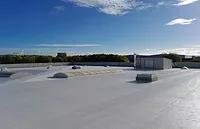Compressed Air Dryer Eliminates Need for Rework in Finishing Operations
"The new membrane dryer provides the driest air that I have ever seen," said Bert Brown, Maintenance manager for the Booneville plant. "We have completely eliminated rework due to moisture contamination, making it possible to re-deploy two people to more productive jobs. The new filters have also cut the cost of repairing spray guns down to virtually zero."
GBC is the market leader in several office product categories including binding machines and supplies, laminating systems, visual communication products, and paper shredders, under the brand names Quartet, Ibico, GBC and Shredmaster. The Booneville operation covers more than 1 million square feet, and makes approximately 24,000 wood and metal marker and bulletin boards per day.
Moisture Causes Problems with Electrostatic Coating
Important subassemblies used in these products such as frames and rails are finished using electrostatic coating methods that apply charged paint particles to a workpiece with an opposite charge. Charged powdered particles or atomized liquid paint is initially projected toward the conductive workpiece by a mechanical or compressed air spraying method and then accelerated toward the workpiece by the powerful electrostatic charge. The subassemblies are carried on a conveyor through 8-foot-wide by 8-foot-deep portable spray booths. In the past, GBC used a deliquescent dryer that uses the natural water absorption properties of salt to dry compressed air that drives the sprayers. In this type of dryer, the compressed air flows over the surface of many salt tablets that remove moisture that is drained away at the bottom.
"The deliquescent dryer wasn't able to consistently remove the moisture from our compressed air," Brown said. "The moisture left spots on the paint in such large numbers that two people had to be permanently assigned to grind off the coating and apply a new finish by hand. The moisture also caused the spray guns to rust, which broke down and clogged them up to the point that we had to regularly send them back to the manufacturer for rebuilding and also maintain a large supply of spare guns for use as replacements. The situation was clearly unacceptable. We considered the conventional approach of using refrigerant dryers but we recognized that these are complicated machines that require a considerable amount of electrical power to run and also need regular maintenance. We saw this as a major negative because we want our maintenance staff to focus their attention on our production machinery."
Membrane Filtrations Provides Solution
"I made some calls to other companies that use compressed air and to equipment suppliers asking if they had any ideas," Brown said. "A company in Memphis told me about a new method that uses membrane dehydration technology rather than refrigeration technology to remove moisture from compressed air. I immediately recognized a key advantage of this approach - the membrane dryers don't have any moving parts to wear out and don't draw any power. The big question in my mind was whether these membrane dryers could really solve our problem, which is compounded by the hot, humid weather that we receive in the summer. I spoke to a few users and they were very satisfied so we decided to install one of the units."
Balston Membrane dryers use membrane separation technology. The compressed air goes into the Balston system but prior to entering the membrane-drying portion of the system, the air passes through two high-efficiency coalescing filters. The filters remove oil and water droplets and particulate contamination with an efficiency of 99.99% at 0.01 micron. Liquids removed by the filter continuously drain from the filter cartridge into the bottom of the housing, where they are automatically emptied by an autodrain assembly. The air leaving the prefilter carries only water vapor, which is removed in the membrane module.
How Membrane Separation Works
The dehydration membranes consist of bundles of hollow membrane fibers. The water vapor in the compressed air is removed by the principle of selective permeation through a membrane. The membrane module consists of bundles of hollow membrane fibers, each permeable only to water vapor. As the compressed air passes through the center of these fibers, water vapor permeates the walls of the fiber, and dry air exits from the other end. A small portion of the dry air (regeneration flow) is redirected along the length of the membrane fiber to carry away the moisture-laden air that surrounds it. The remainder of the dry air is piped to the application.
The model 76-500 Balston Membrane Air Dryer used at Booneville delivers 500 standard cubic feet per minute (scfm) outlet flow with a guaranteed dewpoint of 35?F. The dewpoint is the temperature at which air becomes saturated with water and condensation begins. The inlet pressure can vary between 60 psig and 140 psig and the maximum pressure drop is 6 psi. The unit requires no electricity, is silent and explosion proof and has no desiccant to change. The drying power of the membrane is controlled by varying the compressed air flow rate and pressure. The unit is 51 inches wide by 66 inches high by 28 inches deep and weighs 725 lbs. The dryer is designed to operate continuously, 24 hours per day, 7 days per week.
Results Exceed Expectations
"The results exceeded our expectations," Brown said. "The first day that we installed the new dryer our problems in the paint department ended. We have never seen another spot on a painted surface since then so we were able to move the people that were repainting the parts to different jobs and take down the rework tables. The manager of the paint spray department said he has never seen a single drop of oil or water in the painting system since the new dryer was installed. He told me that if I ever try to take the dryer out of service he will hang me by my toes from the tallest tree in town. We have also cut the cost of repairing the spray guns down to virtually zero. Not long after we installed the membrane dryers, the spray gun vendor came in and asked us if we had switched to a different vendor because the repair orders that they were used to seeing suddenly stopped."Brown said that in the early phases of the implementation process the company learned the importance of removing excess oil from the compressed air lines prior to the membrane dryer. "When we first installed the membrane dryers, although they worked perfectly, we didn't get the cartridge life that we were expecting. We spoke to the manufacturer and discovered the problem was a high concentration of oil in the feeder line from the air compressor. They recommended we install an oil water separator between the compressor and the membrane dryer system to remove the excess oil from the air line. We installed these filters about a year ago and haven't had to replace a single filter yet." Brown said that with the success of this application, the company purchased another membrane dryer system to supply air to a stamping press. This dryer solved the moisture problems that had previously plagued the press operation but the company made the decision later to pipe air in from a different building so that the compressor in that building could be shut down. "The bottom line is that the new membrane dryer paid for itself very quickly by eliminating rework in our paint department," Brown said. "The air it generates is the best that I have ever seen in my life. Since we resolved prefiltration issues, the membrane dryer has been virtually maintenance-free. If we ever needed clean, dry air in another part of our plant, there's no question that we would select another membrane dryer." c
For more information on dryers, contact Parker Hannifin Corp., Filtration and Separation Division, 100 Ames Pond Drive, PO Box 1262, Tewksbury, MA 01876-0962; phone 800/343.4048; fax 978/858.0625; or visit www.balston.com.
Links
Looking for a reprint of this article?
From high-res PDFs to custom plaques, order your copy today!






